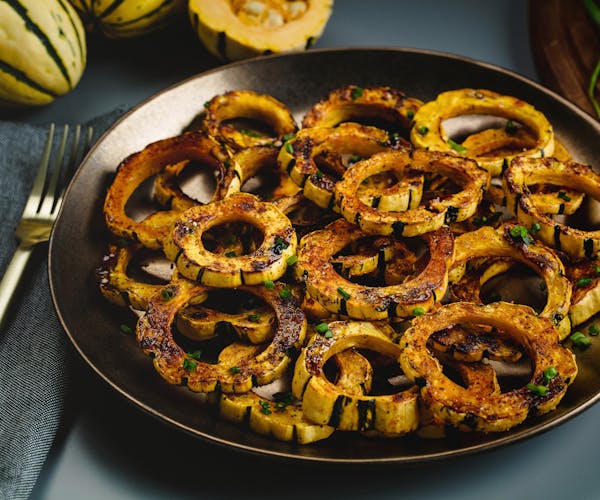Winter squash, in all shapes, colors and sizes, fill the market bins at this time of the year. I like to display a variety on my kitchen counter like pieces of art. All too often, I skip cooking these hard beauties because the task feels daunting.
However, a beautiful tower of golden roasted, sliced delicata squash at a storefront jolted me out of my kitchen laziness. Fantastic. As we gobbled up the tender, slightly sweet squash, skin and all, I vowed to rethink squash at home. Especially since the squash in my display basket clearly mocked me.
Looking for insight, I turned to Deborah Madison's stunningly beautiful tome "Vegetable Literacy" (Ten Speed Press, $40, 2013). In her chapter on the cucurbit family, she says there's no apparent reason to avoid, shun or fear this plant family. Winter squash have more nutritive value, loads of fiber and vitamins than summer squash. They also prove a great value for the dollar, in part, because, they keep well for weeks. Most squash — winter and summer alike — make fine soups, add texture to stews, bronze beautifully on a grill or in the oven and take to savory seasonings as well as acid and sweet additions.
OK, that's enough of a sales pitch. I say let's cook them while we can.
Acorn squash are everywhere, but these days, butternut, spaghetti, delicata, blue Hubbard and sweet dumpling appear regularly at supermarkets and produce stores. I chose small specimens, free of blemishes and soft spots. Look at the stem end — where it was attached to the vine — it should not be too dried out or bruised.
Most winter squash enjoy a steamy environment for cooking. So cook them whole (pierced to allow steam to escape) in the oven or microwave, or speed up the cooking by cutting them into pieces and adding moisture (water, broth, oil) during cooking. Cooked squash keeps several days in the refrigerator and can be frozen. This means it's now a weeknight option.
The simple roasted squash recipe below can be made with nearly any winter squash. Butternut is relatively easy to peel and dice. You can roast other squash with the peel still on, but I like to cut it into wedges so I can easily scoop the soft flesh away from the peel. When roasting squash, don't skimp on the oil; it works to retain the moisture in the flesh.
Stuffed squash makes a great meatless main course or elegant side to a roast chicken dinner. My favorite combination of rice, green chile, corn and cheese makes a terrific stuffing for acorn or delicata squash. I like the dark green vegetable flavor of poblano chiles in contrast to the sweet flavor of winter squash.
When stuffing squash (or bell peppers for that matter), the trick is to cook the squash to tenderness first. Then, season the squash and the filling mixture. A few minutes in the oven will blend the flavors together. Alternatively, skip stuffing the squash. Instead, stir 3 or 4 cups of the simple roasted butternut into the rice filling for a hearty side dish.





